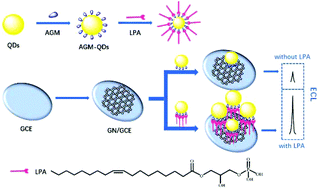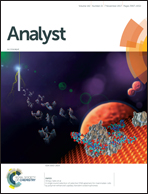A novel CuZnInS quantum dot-based ECL sensing system for lysophosphatidic acid detection†
Abstract
In this paper, a novel electrochemiluminescence (ECL) sensor for lysophosphatidic acid (LPA) detection was developed. LPA consists of a phosphate “head” group, a “linker” region illustrated by glycerol, and a fatty acyl chain as a lipophilic “tail”. The water-soluble quaternary CuInZnS quantum dots (QDs) were modified with agmatine (AGM) molecules as an ECL luminophore. On the one hand, the guanidine groups on the QDs can capture the hydrophilic head of LPA with high selectivity. On the other hand, the electrochemically reduced graphene nanosheets (GNs) modified on the glassy carbon electrode (GCE) surface can bind the LPA lipophilic tail. As a result, the LPA-AGM-CuInZnS QDs were captured on the GNs/GCE. The ECL intensity of the system was enhanced with the increased concentration of LPA. As far as we know, it was the first report about LPA detection based on the ECL nanosensing system. The linear relationship range of LPA sensing is from 2 to 75 μmol L−1. The practicability of this ECL sensing platform had shown satisfactory results in human serum samples.



 Please wait while we load your content...
Please wait while we load your content...